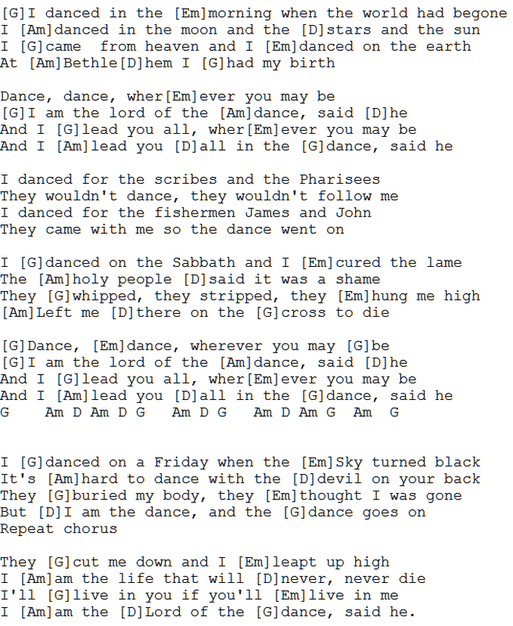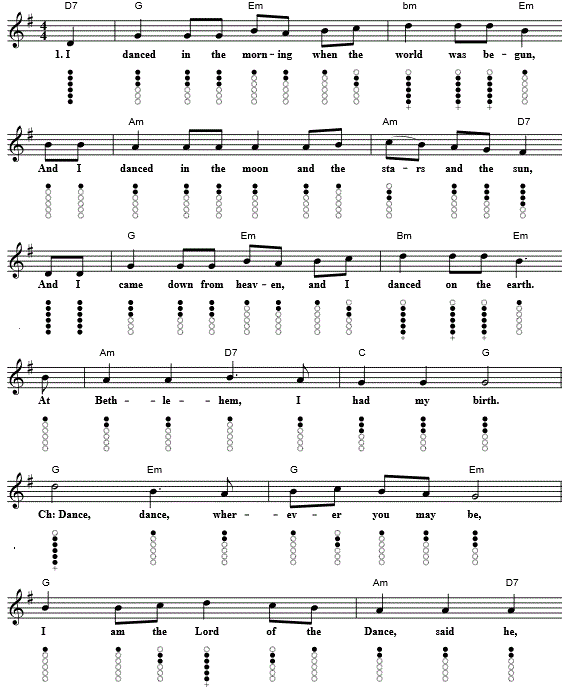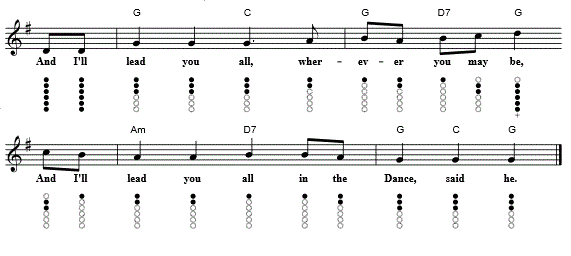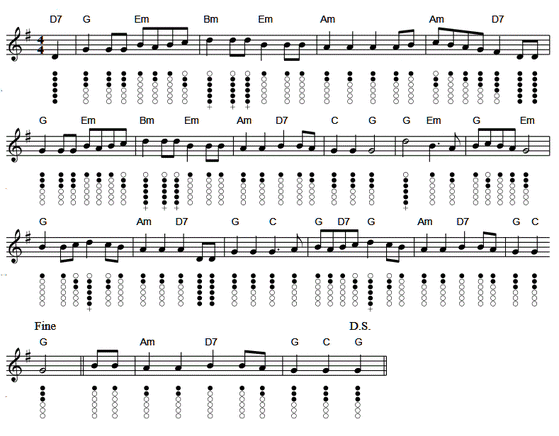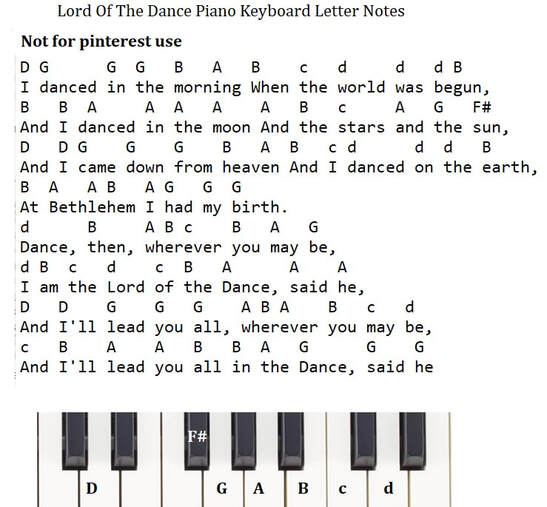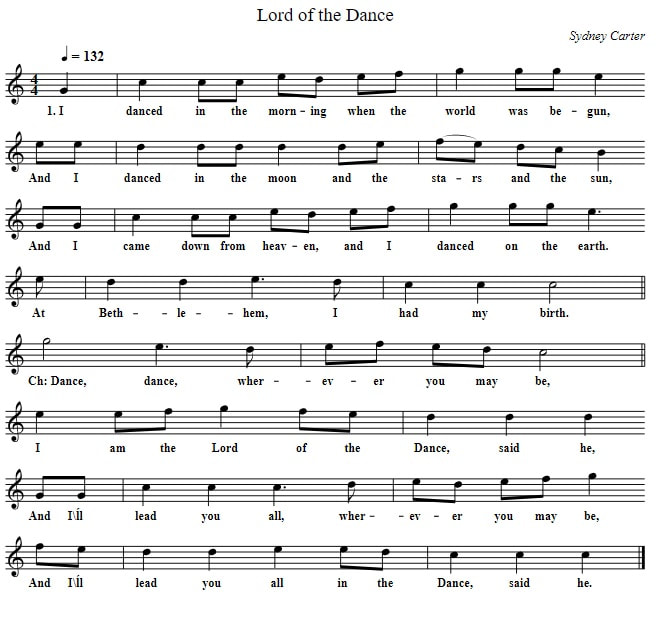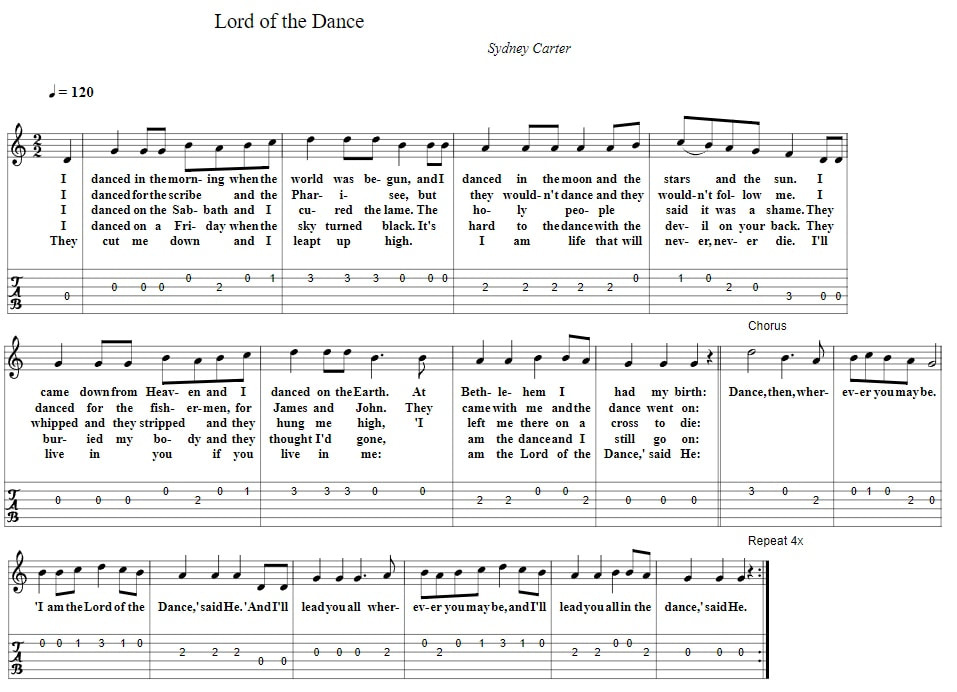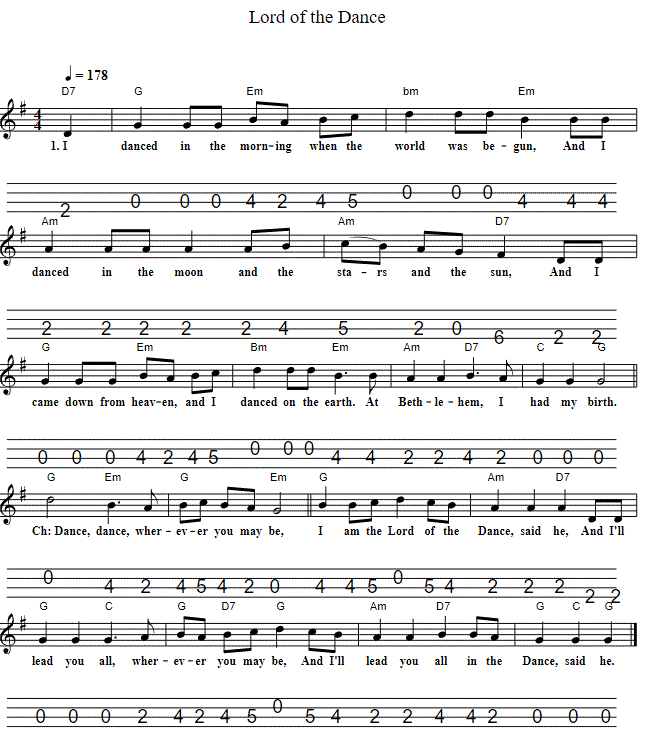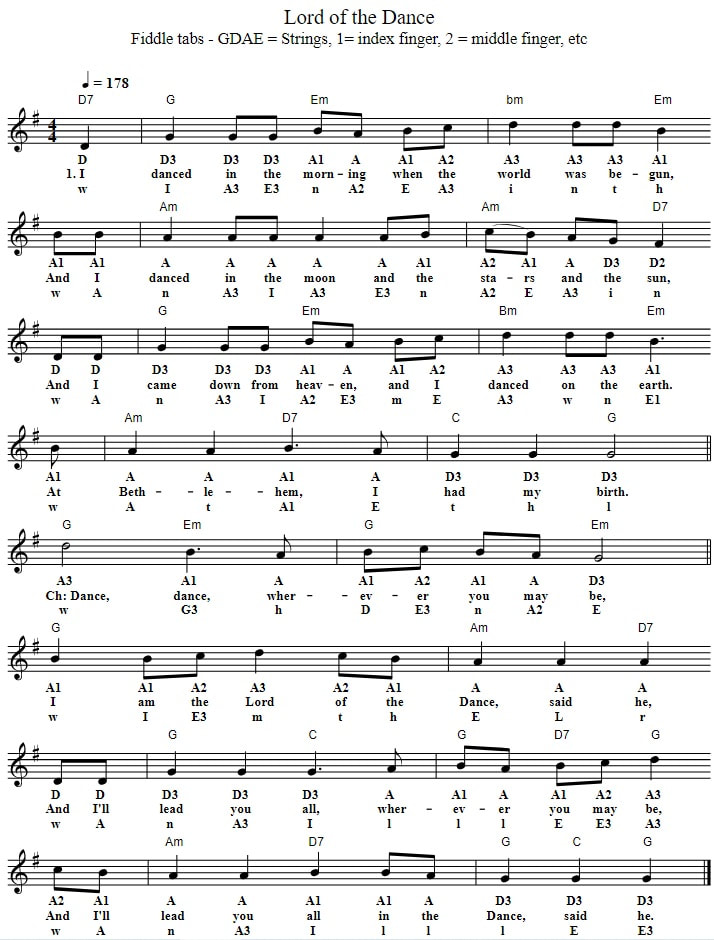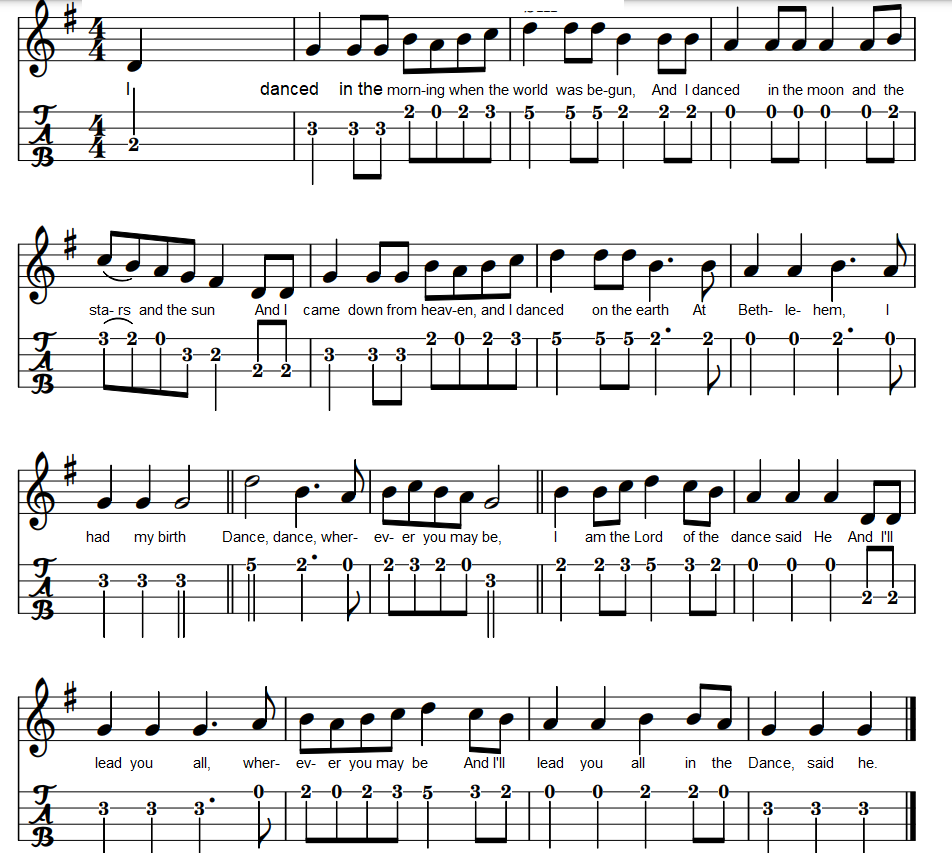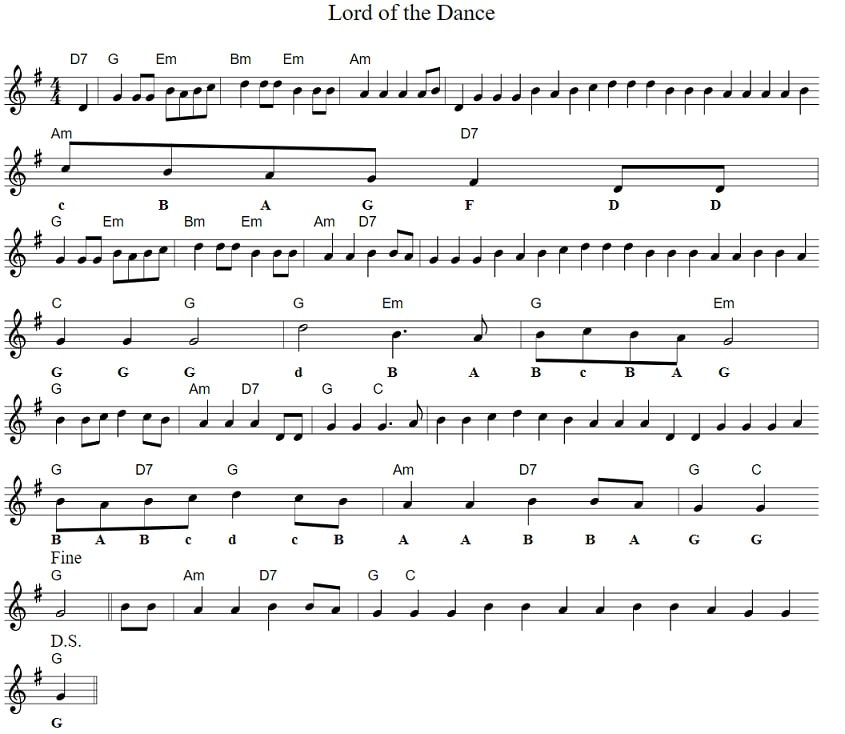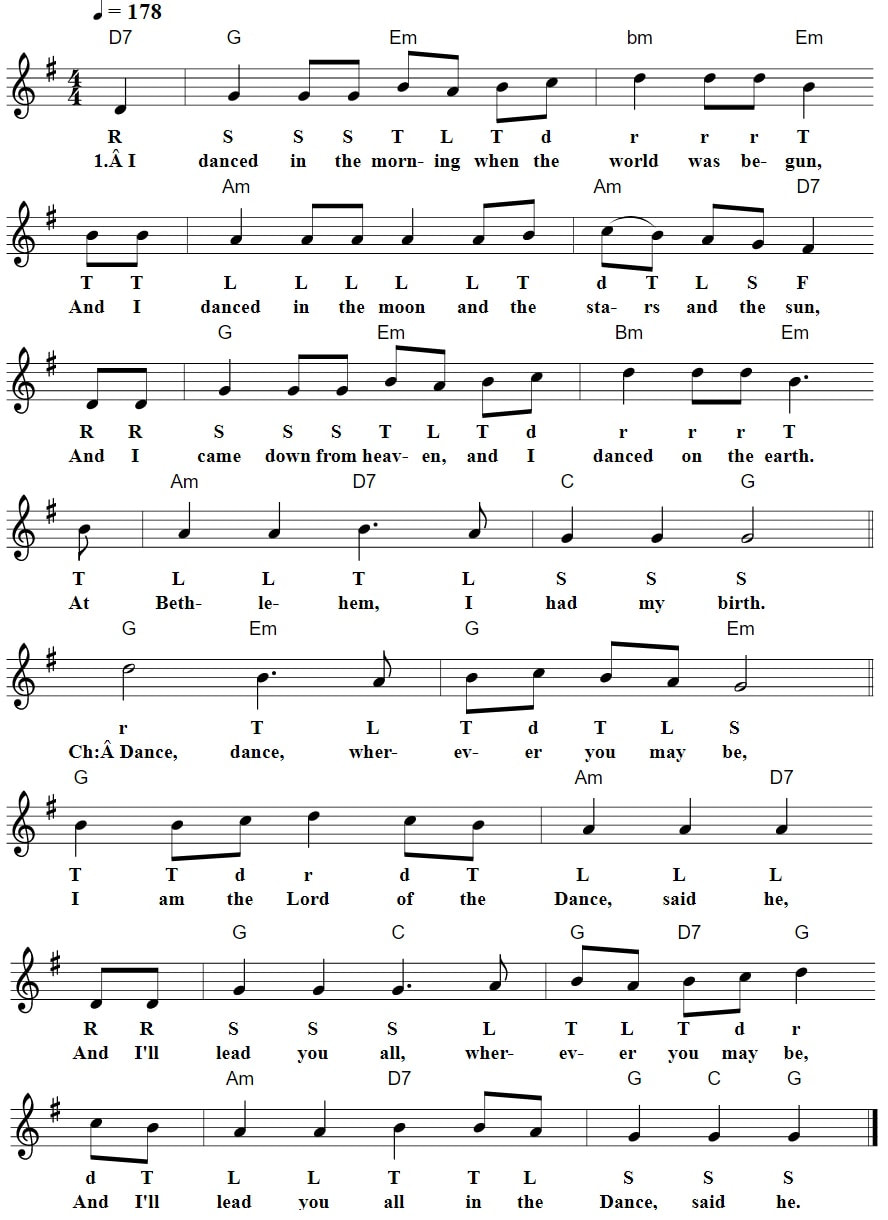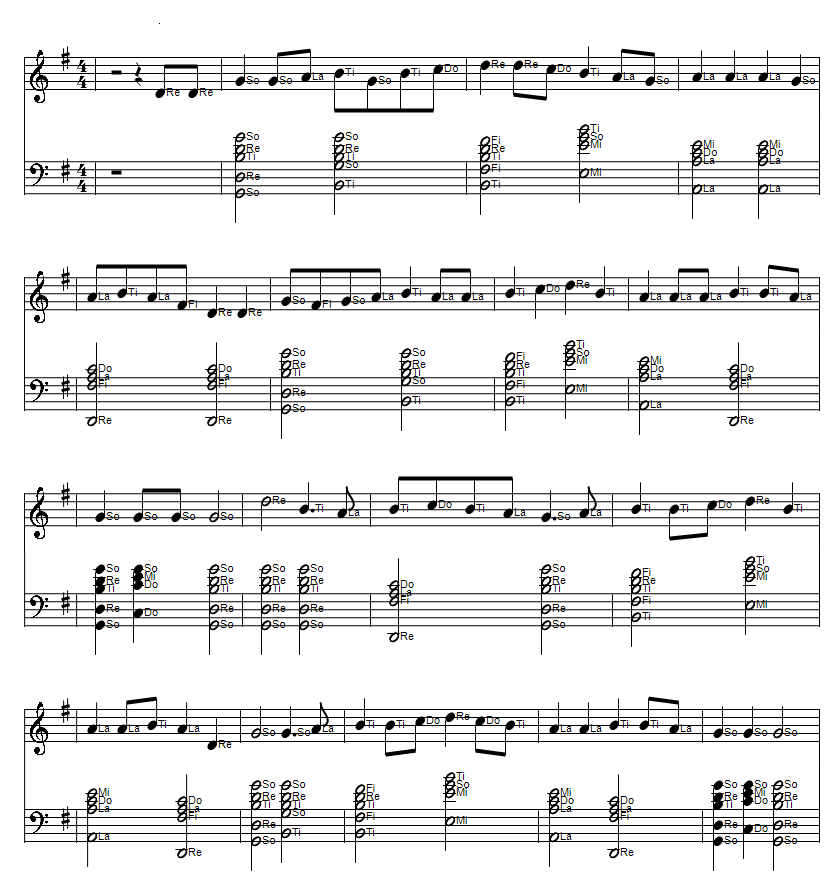Lord Of The Dance Lyrics Guitar Chords And Tin Whistle Sheet Music
This song was written by Sydney Carter in 1963, the tune of the song is Simple Gifts which is much older. The easy piano keyboard / accordion letter notes are included plus beginner fiddle tab. Lord of the dance solfege [ Do re mi ] sheet music notes in G Major now added. Recorded by Angelo Kelly And The Kelly Family in the year 2019. Many people assume this is an Irish song, well it's not. Sydney Carter was a poet and folk singer from Camden Town, London. The version of the guitar chords here are for The Dubliners live version with Jim McCann singing. The tin whistle notes and sheet music is included and the sheet uses a different set of chords to the lyrics version. Also recorded by The Corries, Foster And Allen, The Alexander Brothers,André Rieu and orchestra, and The Irish Rovers. The last version of the sheet music has the letter notes. Lord of the dance tenor guitar / mandola tab in CGDA added. Also the ukulele tab in open G tuning.
Below is the list of sheet music and tin whistle songs that are in my ebooks. This is the largest collection of tin whistle songs ever put together.[over 800 songs ] Including folk, pop and trad tunes plus German And French songs along with Christmas Carols.
All of the sheet music tabs have been made as easy to play as was possible.
The price of the ebooks is €7.50
All of the sheet music tabs have been made as easy to play as was possible.
The price of the ebooks is €7.50
Lord of the dance sheet music notes in C Major
Included below is the 6 string standard tuning guitar tab.
Below is the tenor guitar / mandola tab in CGDA
Lord of the dance ukulele tab in open G tuning
Lord of the dance solfege [ Do re mi ] sheet music notes in G Major
Introduction
The song 'Lord of the Dance' has been captivating audiences for decades with its powerful lyrics, energetic rhythm, and iconic dance moves. Written by Sydney Carter in the 1960s, this song has become a timeless classic, inspiring countless covers and adaptations. Its enduring popularity can be attributed to its rich history, meaningful message, and universal appeal. In this thesis, we will examine the origins and evolution of the song 'Lord of the Dance', its significance in popular culture, and the enduring impact it has had on audiences worldwide.
Origins and Evolution
The origins of 'Lord of the Dance' can be traced back to the 1960s, a time of cultural and political upheaval. It was during this period that Sydney Carter, a British folk singer and songwriter, wrote the lyrics to the song. Carter was known for his poetic and thought-provoking lyrics, and 'Lord of the Dance' was no exception. The lyrics drew inspiration from the traditional English carol 'Simple Gifts' and the Shaker hymn 'Lord of the Dance', as well as the Hindu deity Shiva, who is often depicted as the lord of dance in Hindu mythology. Carter's lyrics spoke of the universal presence of a dancing deity, who symbolized joy, freedom, and the power of love and unity.
The song gained popularity in the 1970s, when it was recorded by the Irish folk group The Dubliners. It was their rendition of the song that introduced the iconic melody and upbeat rhythm that is now synonymous with 'Lord of the Dance'. The song's popularity continued to grow, and it was soon covered by numerous artists, including The Kingston Trio, The Corries, and The Chieftains. It also made its way into popular culture, being featured in movies, TV shows, and even video games.
Meaning and Message
At its core, 'Lord of the Dance' is a song about unity and celebration. The lyrics speak of a dancing deity who is present in all aspects of life, from the joy of birth to the sorrow of death. This deity is a symbol of love, joy, and freedom, and the song encourages listeners to join in the dance and embrace these universal values. The message of the song is one of hope and optimism, reminding us that even in the darkest of times, there is always something to celebrate and be grateful for.
The song's message of unity and celebration has resonated with audiences worldwide, making it a popular choice for weddings, funerals, and other significant events. Its simple yet powerful lyrics have also made it a popular choice for school choirs, church services, and other community events. The song's broad appeal and its ability to transcend cultural and religious boundaries have made it a ubiquitous part of popular culture.
Impact and Legacy
'Lord of the Dance' has had a significant impact on popular culture, inspiring numerous covers and adaptations. In 1996, the song was adapted into a popular stage show, also titled 'Lord of the Dance'. The show has been performed in over 60 countries and has been seen by over 60 million people, cementing the song's status as a global phenomenon. The show's success also led to a film adaptation in 2011, further solidifying the song's enduring legacy.
The song's popularity has also led to its use in various social and political movements. In the 1980s, it was adopted as an anthem for the peace movement in Northern Ireland, with the lyrics being changed to reflect the desire for unity and an end to violence. It has also been used as a rallying cry for various social justice causes, with its message of hope and unity resonating with those seeking positive change in the world.
Conclusion
In conclusion, 'Lord of the Dance' is more than just a song; it is a cultural phenomenon that has stood the test of time. Its origins and evolution, meaningful message, and universal appeal have made it a beloved and iconic piece of music. From its humble beginnings in the 1960s to its enduring impact on popular culture, 'Lord of the Dance' continues to captivate audiences and inspire them to join in the dance of life.
The song 'Lord of the Dance' has been captivating audiences for decades with its powerful lyrics, energetic rhythm, and iconic dance moves. Written by Sydney Carter in the 1960s, this song has become a timeless classic, inspiring countless covers and adaptations. Its enduring popularity can be attributed to its rich history, meaningful message, and universal appeal. In this thesis, we will examine the origins and evolution of the song 'Lord of the Dance', its significance in popular culture, and the enduring impact it has had on audiences worldwide.
Origins and Evolution
The origins of 'Lord of the Dance' can be traced back to the 1960s, a time of cultural and political upheaval. It was during this period that Sydney Carter, a British folk singer and songwriter, wrote the lyrics to the song. Carter was known for his poetic and thought-provoking lyrics, and 'Lord of the Dance' was no exception. The lyrics drew inspiration from the traditional English carol 'Simple Gifts' and the Shaker hymn 'Lord of the Dance', as well as the Hindu deity Shiva, who is often depicted as the lord of dance in Hindu mythology. Carter's lyrics spoke of the universal presence of a dancing deity, who symbolized joy, freedom, and the power of love and unity.
The song gained popularity in the 1970s, when it was recorded by the Irish folk group The Dubliners. It was their rendition of the song that introduced the iconic melody and upbeat rhythm that is now synonymous with 'Lord of the Dance'. The song's popularity continued to grow, and it was soon covered by numerous artists, including The Kingston Trio, The Corries, and The Chieftains. It also made its way into popular culture, being featured in movies, TV shows, and even video games.
Meaning and Message
At its core, 'Lord of the Dance' is a song about unity and celebration. The lyrics speak of a dancing deity who is present in all aspects of life, from the joy of birth to the sorrow of death. This deity is a symbol of love, joy, and freedom, and the song encourages listeners to join in the dance and embrace these universal values. The message of the song is one of hope and optimism, reminding us that even in the darkest of times, there is always something to celebrate and be grateful for.
The song's message of unity and celebration has resonated with audiences worldwide, making it a popular choice for weddings, funerals, and other significant events. Its simple yet powerful lyrics have also made it a popular choice for school choirs, church services, and other community events. The song's broad appeal and its ability to transcend cultural and religious boundaries have made it a ubiquitous part of popular culture.
Impact and Legacy
'Lord of the Dance' has had a significant impact on popular culture, inspiring numerous covers and adaptations. In 1996, the song was adapted into a popular stage show, also titled 'Lord of the Dance'. The show has been performed in over 60 countries and has been seen by over 60 million people, cementing the song's status as a global phenomenon. The show's success also led to a film adaptation in 2011, further solidifying the song's enduring legacy.
The song's popularity has also led to its use in various social and political movements. In the 1980s, it was adopted as an anthem for the peace movement in Northern Ireland, with the lyrics being changed to reflect the desire for unity and an end to violence. It has also been used as a rallying cry for various social justice causes, with its message of hope and unity resonating with those seeking positive change in the world.
Conclusion
In conclusion, 'Lord of the Dance' is more than just a song; it is a cultural phenomenon that has stood the test of time. Its origins and evolution, meaningful message, and universal appeal have made it a beloved and iconic piece of music. From its humble beginnings in the 1960s to its enduring impact on popular culture, 'Lord of the Dance' continues to captivate audiences and inspire them to join in the dance of life.
